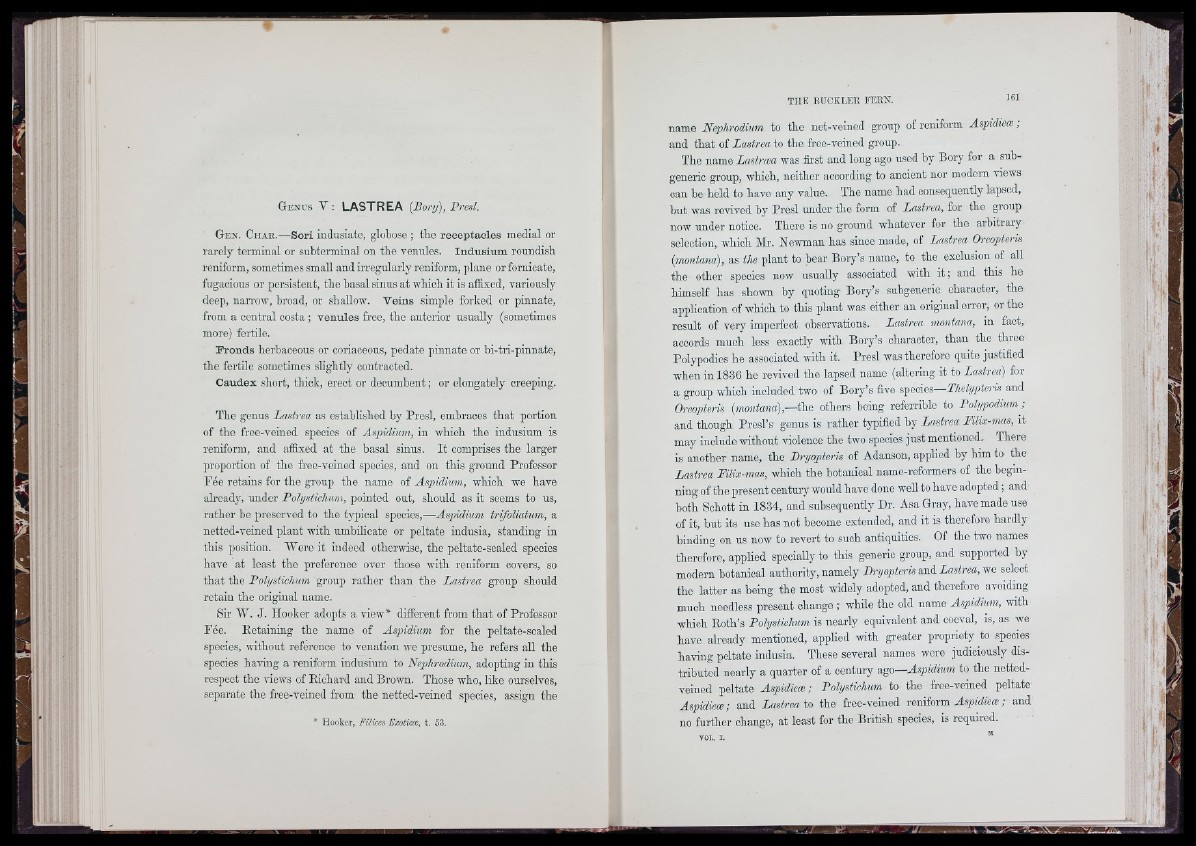
G enus V : LASTREA {Bory), Presl.
Gen. Char.—Sori indusiate, globose ; the receptacles medial or
rarely terminal or subterminal on the venules. Indusium roundish
reniform, sometimes small and irregularly reniform, plane or fornicate,
fugacious or persistent, the basal sinus at which it is affixed, variously
deep, nan-ow, broad, or shallow. Veins simple forked or pinnate,
from a central costa ; venules free, the anterior usually (sometimes
more) fertile.
Fronds herbaceous or coriaceous, podate pinnate or bi-tri-pinnate,
the fertile sometimes slightly contracted.
Caudex short, thick, erect or decumbent ; or elongately creeping.
The genus Lastrea as established by Presl, embraces th a t portion
of the free-veinod species of Aspidium, in which the indusium is
reniform, and affixed at the basal sinus. I t comprises the larger
proportion of tho free-veined species, and on this ground Professor
Fée retains for the group tho name of Aspidium, which we have
already, under Polystichum, pointed out, should as it seems to us,
rather be preserved to the typical species,—Aspidium trifoliatum, a
netted-veinod plant with umbilicato or peltate mdusia, standing in
this position. IVere it indeed otherwise, the peltate-sealed species
have at least the preference over those with reniform covers, so
that the Polystichum group rather than the Lastrea group should
retain the original name.
Sir IV. J. Hooker adopts a view* different from that of Professor
Fée. Retaining the name of Aspidium for the peltate-scaled
species, without reference to venation we presume, he refers all the
species having a reniform indusium to Nephrodium, adopting in this
respect the riews of Richard and Brown. Those who, like ourselves,
separate the free-veined from the netted-veined species, assign the
* Hooker, Filices Exoticce, t. 53.
name Nephrodium to the net-veined group of roniform Aspidiem;
and that of Lastrea to the free-veined group.
The name Lastrcea was first and long ago used by Bory for a sub-
generio group, which, neither according to ancient nor modern views
can he held to have any value. The name had consequently lapsed,
but was revived by Prosl under tbe form of Lastrea, for the group
now under notice. There is no ground whatever for the arbitrary
selection, which Mr. Newunan has since made, of Lastrea Oreopteris
{montana), as the plant to bear Bory’s name, to the exclusion of all
the other species now usually associated with it ; and this he
himself has shovm by quoting Bory’s subgenerio oharaoter, the
application of which to this plant was either an original error, or the
result of very imperfect observations. Lastrea montana, in fact,
accords much less exactly with Bory’s character, than the three
Polypodies he associated with it. Presl was therefore quite justified
when in 1836 he revived the lapsed name (altering it to Lastrea) for
a group which included two of Bory’s five species— Thelypteris and
Oreopteris {montana),— iko others boing referrible to Polypodmm;
and though Presl’s genus is rather typified by Lastrea Filix-mas, it
may include without violence the two species just mentioned. There
is another name, the Dryopteris of Adanson, applied hy him to the
Lastrea Filix-mas, which the botanical name-reformers of the beginning
of the present century would have done well to have adopted; and
both Schott in 1834, and subsequently Dr. Asa Gray, have made use
of it, hut its use has not become extended, and it is therefore hardly
binding on ns now to revert to such antiquities. Of the two names
therefore, applied specially to this generic group, and supported by
modern botanical authority, namely Dryopteris and Lastrea, we select
the latter as being the most widely adopted, and therefore avoiding
much needless present change ; while the old name Aspidium, with
which Roth’s Polystichum is nearly equivalent and coeval, is, as we
havo already mentioned, applied with greater propriety to species
having peltate indusia. These several names were judiciously distributed
nearly a quarter of a century ago—Aspidium to the netted-
veined peltate Aspidiem; Polystichum to the free-veined peltate
Aspidiem; and Lastrea to the free-veined renAorm Aspidiem; and
no further change, at least for the British species, is required.